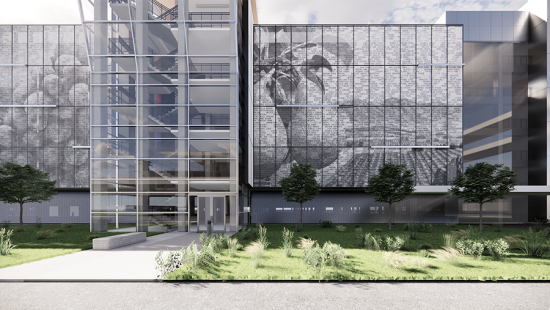Stories Last Longer Than Symbols
With Who is Afraid of Natasha? Art Professor of the Practice Joanna Malinowska and collaborator C.T. Jasper bring a monument (back) to life.
 Film still from Who is Afraid of Natasha? (2021). image / provided
Film still from Who is Afraid of Natasha? (2021). image / provided"Natasha" is the nickname given to a statue of an everyday woman that, from 1953 to 1990, stood in Tadeusz Kościuszki Square in the Baltic port city of Gdynia, Poland. A modest bronze figure created in the Socialist Realism style of the times, she was neither a fighter nor a hero. Natasha was a celebration of the Soviet-Polish alliance that liberated the country during WWII and the placement of the monument politicized the public square. It also signaled a westward-facing, progressive march toward Europe. Among residents of Gdynia, Natasha was appreciated for her style and eventually became a public meeting point — though, for many who lived through the postwar period, she also symbolized the limitations imposed on daily life by Soviet-era communism. When the system collapsed in 1990, the statue was — with much public fanfare and celebration — removed and relocated to the Russian quarter of the Gdynia war cemetery.
 Who is Afraid of Natasha? (2021) sculptural installation in Bruges, Belgium for the 2021 Bruges Triennial. photo / Jasper van het Groenewoud
Who is Afraid of Natasha? (2021) sculptural installation in Bruges, Belgium for the 2021 Bruges Triennial. photo / Jasper van het GroenewoudToday, a recreation of Natasha stands in the courtyard of the Begijnhof in Bruges, Belgium. The reconstructed, reimagined statue and a narrative film together comprise Who is Afraid of Natasha?, an artwork by art Professor of the Practice Joanna Malinowska and her longtime collaborator C.T. Jasper, both originally from Gdynia. The new work was commissioned for the 2021 Bruges Triennial to interpret and explore the event's theme, TraumA. The typographic distinction in the title reveals the German word for "dream" (traum) situated in the now universal term, "trauma," and the exhibition plays on this double meaning. Ambiguities between trauma and dreaming are exploited conceptually through the thematic content of selected artworks, as well as spatially through architectural and urban interventions that activate different corners of the city of Bruges.
In its new location, Malinowska and Jasper's sculptural element of Who is Afraid of Natasha? illuminates the site of a former women's commune, a refuge for "XIII-century feminists" who were there afforded social and economic independence and a lay religious life without renouncing the world. Their version of Natasha is also marked by a red lightning bolt, calling into the space the contemporary struggles of the Strajk Kobiet movement in Poland, which actively fights for women's reproductive rights against reinvigorations of draconian abortion restrictions. Malinowska explains, "We were thinking that every nation has suffered some form of trauma throughout its history. For Poland, one of the traumatic periods was communism. For Belgians, it is currently coming to terms with the country's colonial past and the predatory politics of King Leopold II. Every nation has its demons."
 Film still from Who is Afraid of Natasha? (2021). image / provided
Film still from Who is Afraid of Natasha? (2021). image / provided
With the video that plays inside the Begijnhof, we learn that Natasha is, or always was, an allegory, and a part of many other stories. Viewers get a composite portrait of Natasha that includes narration from dozens of curators, historians, and residents of Gdynia. They are filmed in their homes, offices, and in public space, as the video highlights the more industrial corners of the city. These storytellers are all on the phone (a formal solution to pandemic conditions), which gives the effect of listening in on friends in conversation, catching up, and sharing their thoughts with each other — rather than an invisible someone behind the camera. Among these accounts, we learn that Natasha was part of a love story between the monument's creator, Marian Wnuk, and his lover, artist, and the model for the sculpture, Magdalena Więcek — who then went on to establish herself as a successful sculptor.
Malinowska herself recounts, "I didn't know about the removal until one day when, during my usual summer or winter visit to my home city, I went for a walk and saw that the statue was gone. I clearly remember the impression that something was missing; something was different. At first, I didn't know what — and then, I realized that Natasha was no longer standing in the middle of the square." According to Malinowska, it is possible for the original statue, its removal, as well as its reconstruction to be viewed together as a provocation to reopen and reexamine the past.
As Malinowska has articulated in her own reflections and revealed with the piece's inclusion of multiple accounts of life with and without Natasha in the square, trauma and ways of coping with it come in many forms. Symbolism can be left to interpretation. Stories suture lives and worlds. Bringing an interest in anthropology that has also influenced many of their previous collaborative works, Malinowska and Jasper highlight the social histories behind the monument. By re-siting and re-staging cultural fragments from one context to another, similar to their work for the Polish Pavilion at the 2015 Venice Biennale, Halka in Haiti, Malinowska and Jasper create juxtapositions that bring into stark relief the consequences of previous dislocations imposed by communism, capitalism, colonialism, and empire, among other present and historical forces. With Who is Afraid of Natasha? the artists ask yet another question: What if a monument did not have to be fixed relative to one point in history, or one place, but could instead come alive, be remade, and given new meaning?
Stay connected! Follow @cornellaap on instagram, facebook, twitter, and linkedIn; and subscribe to our AAP bi-weekly newsletter.







